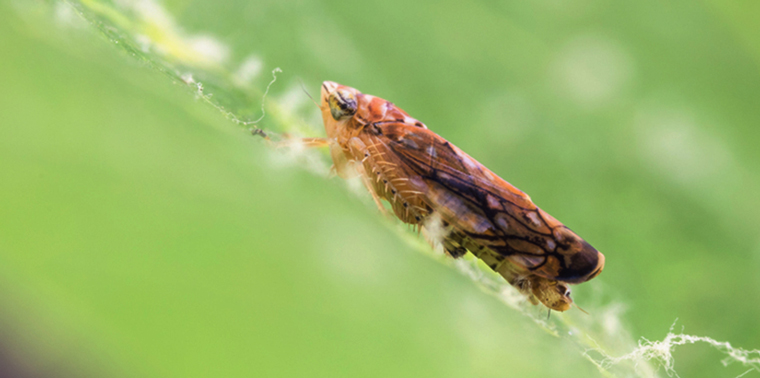April 4, 2018 — Entomologists have taken the act of bugging conversations to a whole new level — recording sexual vibrations emitted by tiny insects living on grapevines in vineyards. What may seem like a callous act of insect espionage is actually an innovative technique in pest management, decades in the making, chemical free and not lethal to anything.
Vineyards across the U.S. and Italy are being devastated by incurable diseases caused by bacteria hitching a ride on leafhoppers — a diverse group of plant-piercing insects closely related to cicadas. Now, thanks to some innovative research, scientists are using a technique called vibrational mating disruption to interrupt male-leafhopper courtship songs, preventing them from finding mates and slowing population growth.
Devastating for Grapes
Leafhoppers use soundless vibrations to exchange information with each other. They are quite small (commonly 6–13 millimeters [0.25-0.5 inches] long), are strong jumpers (one species has a take-off velocity of 2.9 meters [9.5 feet] per second), and have piercing-sucking mouthparts they use to access and slurp up plant sap.
A male leafhopper eager to woo a female rapidly vibrates its abdomen, sending low-frequency vibrations through plants. If a female picks up the signal and responds, an intricate vibrational duet ensues. The male moves closer and closer to the female, guided by her vibrational responses, eventually the two find each other, mate and produce more leafhoppers.
This is good news for the leafhopper, but it can be devastating for grapes and other economic crops.
In southern California, an invasive leafhopper called the glassy-winged sharpshooter (Homalodisca vitripennis) transmits Pierce’s disease — an incurable grape-plant infection. In California alone, Pierce’s disease results in about US$104 million a year in lost production and costs associated with defending their crops from the pests.
Similarly, over the pond in Italy, the American grapevine leafhopper (Scaphoideus titanus) transmits Flavescence dorée disease — a highly contagious and incurable infection of grapevines in Europe.

This northern Italy vineyard uses minishakers (white boxes on top of trellis posts) to send out vibrations that disrupt mating communication in leafhoppers that attack grape plants. Photo courtesy of Valerio Mazzoni
Grape farmers commonly protect crops from insects by repeatedly applying broad-spectrum chemical pesticides, which have a tendency to pretty much kill everything, even beneficial insects.
“There is great concern about this pest at the European level, and mandatory insecticide use is in place to try to control it,” says Valerio Mazzoni, a research scientist in agricultural entomology at Edmund Mach Foundation of San Michele all’Adige.
Communication Breakdown
An alternative approach is to use traps laced with highly specific insect-attracting scents called pheromones that lure pests into killing chambers. But not all insects have the chemical receptors necessary to respond to pheromones, so a gap in pest management remains.
Now, however, Mazzoni and other researchers are exploiting leafhoppers’ vibrational communication channels to stop them from spreading. They run controlled lab experiments and field trials to capture the frequencies and amplitudes of vibrations produced between male and female pairs. Then they use digital electronic shakers about the size of your fist to emit vibrations back in order to determine which signals are ideal for disrupting leafhoppers’ “sweet nothings.”
Listen: The American grapevine leafhopper male courtship song. Courtesy of Valerio Mazzoni
“We are finding weak links in their communication system, and those are the places that we go into and interfere,” says Rodrigo Krugner, a research entomologist with the USDA–Agricultural Research Service in Parlier, California, who is working on vibrational mating disruption.
The male-female duet is a major element in the whole mating process and happens to be very vulnerable to disruption. The researchers use aggressive signals that Krugner describes as “mimicking shouting matches” between rival males or continuously overlapping female signals to disrupt the duet and suppress the male leafhopper’s ability to identify, locate and ultimately mate with the female.
Vibrational mating disruption is a product of a little bit of technology and a whole lot of research on insect behavior. The researchers use a laser doppler vibrometer to detect and record vibrations, while a prototype shaker called TREMOS sends the vibrations through plants. Scientists, like Krugner and Mazzoni, observe leafhopper reactions during playback experiments and can use their observations to guide protocols viticulturists could use to disrupt insect mating in their vineyards. To make this setup suitable for field trials, a series of shakers are strategically placed along vineyard rows and attached to trellis wires that hold up grapevines, which help transport vibrations onto multiple plants.
What the Future Holds
Currently, Mazzoni and Krugner are testing vibrational mating disruption only on leafhopper species within small-scale experimental vineyards in the U.S. and Italy. However, with an estimated 150,000 species of insects around the globe believed to solely use some sort of vibrational signaling, the potential is far greater.
The amount of energy needed to run the shakers is one factor impeding large-scale applications. Using only a portion of the leafhoppers’ vibrational spectrum, specifically the lower frequencies, seems to be a promising tactic to achieve better energy efficiency.
Krugner and Mazzoni see a future for this research in emitting signals that affect a wider range of pest insects across a diversity of agricultural crops.Krugner and Mazzoni see a future for this research in emitting signals that affect a wider range of pest insects across a diversity of agricultural crops, all while collecting external environmental data. To get closer to this holistic approach, vibrational mating disruption is likely to benefit from advancements in agricultural production and vibration detection technologies.
“Technology is going so fast that when I started 10 years ago, I was thinking that this wasn’t possible in the field, and now we are in the field,” says Mazzoni. “What we think is a problem now will likely be solved in another 10 years.” ![]()
Editor’s note: Christopher Bobryk produced this feature as a participant in the Ensia Mentor Program. His mentor for the project was Rachel Cernansky.
Ensia shares solutions-focused stories free of charge through our online magazine and partner media. That means audiences around the world have ready access to stories that can — and do — help them shape a better future. If you value our work, please show your support today.
Yes, I'll support Ensia!
